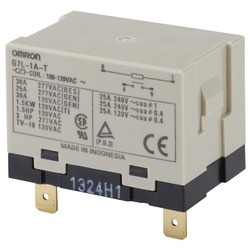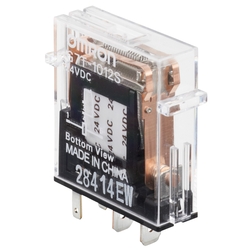(!)NOTE : Windows 7 users won’t be able to use some latest features of eCatalog/WOS since Microsoft is ending support for Windows 7 on 14 Jan, 2020. Please upgrade your system for uninterrupted services.
- Notice of End of Sales for Economy Series Pneumatic Equipment Category. More information.
Industrial Relays(Contact Configuration:1a)
Brand |
|
|---|---|
| CAD |
|
| Days to Ship |
|
2 items
- Sort By
-
You can add up to 6 items per a category to the compare list.

OMRON
A power relay with a high capacity and high dielectric strength that can handle momentary voltage drops.
[Features]
·No contact chattering for momentary voltage drops up to 50% of the rated voltage.
·A wide range coil that covers 100 V AC type from 100 to 120 V AC 50/60 Hz or 200 V AC type from 200 to 240 V AC 50/60 Hz with a single coil.
· High capacity that is particularly able to manage inductive loads with powerful force.
·All insulating materials are flame retardant and comply with UL94 V-0 standards.
· Comes in a wide variety of types including tab terminals, screw terminals, PCB terminals, etc. Surface connection sockets are also available.
·Standard products compliant with UL, CSA, and TÜV and meet the IEC950 standards.
· Safe design with 3 mm contact gap.
[Applications]
·Widely applicable to factory automation as well as non-factory automation equipment.- Volume Discount
Coil rated voltage (DC)(V) Contact Configuration Terminal shape Contact rated current (minimum value for AC and DC)(A) Coil rated voltage (AC)(V) Application Latch function Representative Standard Dimension height(mm) Dimension width(mm) Dimension depth(mm) 12 ~ 24 1a Tab Terminal / Screw Fastening 25 ~ 30 100/120 ~ 200/240 Power - - 49 ~ 55 52.5 ~ 68.5 34.5 From: ₹ 681.00 Days to Ship: Same day or more  Same day or more
Same day or more
-
You can add up to 6 items per a category to the compare list.

OMRON
[Features]
· W29 × D10 × H32 mm I/O slim relay.
· For input (DC, AC).
· Slim type for output (1a, 1b, 1c).
· Output-use type has a high durability of 1 million uses (DC24V5A).
· Comes with operation display mechanism for checking operation (1a only).
· Certified by overseas standard UL, CSA (products marked with * on category chart).Coil rated voltage (DC)(V) Contact Configuration Terminal shape Contact rated current (minimum value for AC and DC)(A) Coil rated voltage (AC)(V) Application Latch function Representative Standard Dimension height(mm) Dimension width(mm) Dimension depth(mm) 12 ~ 24 1a Socket / plug-in 1 ~ 5 100/110 ~ 200/220 Power NA UL / CSA 32 33.5 10 From: ₹ 340.00 Days to Ship: Same day  Same day
Same day
| Brand |
|---|
| Product Series |
| From |
| Days to Ship |
| Coil rated voltage (DC)(V) |
| Contact Configuration |
| Terminal shape |
| Contact rated current (minimum value for AC and DC)(A) |
| Coil rated voltage (AC)(V) |
| Application |
| Latch function |
| Representative Standard |
| Dimension height(mm) |
| Dimension width(mm) |
| Dimension depth(mm) |
You can add up to 6 items per a category to the compare list. | You can add up to 6 items per a category to the compare list. | |
| Brand | OMRON | OMRON |
| Product Series | ||
| From | ₹ 681.00 | ₹ 340.00 |
| Days to Ship | Same day or more | Same day |
| Coil rated voltage (DC)(V) | 12 ~ 24 | 12 ~ 24 |
| Contact Configuration | 1a | 1a |
| Terminal shape | Tab Terminal / Screw Fastening | Socket / plug-in |
| Contact rated current (minimum value for AC and DC)(A) | 25 ~ 30 | 1 ~ 5 |
| Coil rated voltage (AC)(V) | 100/120 ~ 200/240 | 100/110 ~ 200/220 |
| Application | Power | Power |
| Latch function | - | NA |
| Representative Standard | - | UL / CSA |
| Dimension height(mm) | 49 ~ 55 | 32 |
| Dimension width(mm) | 52.5 ~ 68.5 | 33.5 |
| Dimension depth(mm) | 34.5 | 10 |
Loading...
Configure
Specification/Dimensions
-
Coil rated voltage (DC)(V)
-
Contact Configuration
- 1a
- 1b
- 1c
- 2a
- 2c
- 3c
- 4c
- Other
-
Terminal shape
- Socket / plug-in
- Solder
- For Circuit Boards
- Tab Terminal
- Screw Fastening
- Other
-
Contact rated current (minimum value for AC and DC)(A)
-
Coil rated voltage (AC)(V)
-
Application
- Power
- Other
-
Latch function
- Available
- NA
-
Representative Standard
-
Dimension height(mm)
-
Dimension width(mm)
-
Dimension depth(mm)
Related Categories to Industrial Relays
FAQ Industrial Relays
- Question: How many types of relays (industrial relays)?
- Answer: There are various types of relays, and they are classified into different categories according to their properties.
Based On Operation Principles (4 types)
1.1 Electrothermal Relay, an electrothermal relay is made up of a bimetallic (made up of two metals having different thermal expansion coefficients) strip.
1.2 Electromechanical relays This type of relay uses electrical power to move the electromagnetic coil. to control the movement of the contact.
1.3 Solid State Relay, SSR relay is made up of semiconductors instead of mechanical parts and it works on isolating the low voltage circuit from the high voltage circuit using an optocoupler.
1.4 Hybrid Relay, Hybrid relays are made using both SSR and EMR relays. As we know that the SSR wastes power in form of heat and EMR has a contact arcing problem. The hybrid relay uses both SSR and EMR to overcome their disadvantages.
Based on Poles and Throw (4 types)
2.1 SPST (single pole single throw) relay
The single pole means that it can control only one circuit while the single throw means its pole has only one position in which it can conduct.
2.2 SPDT (single pole double throw) relay
The single pole means it can control only one circuit at a time. The double throw means its pole has two positions in which it can conduct.
2.3 DPST (double pole single throw) relay
The double pole means it can control two completely isolated individual circuits. The single throw means that each pole has one position in which it can conduct.
2.4 DPDT (double pole double throw) relay
The double pole means it can control two circuits while the double throw means each pole can conduct in two separate positions. - Question: What is the Operation principle and connection method of relays (industrial relays)?
- Answer: A relay is an electrical switch that controls (switches on and off) a high-voltage circuit using a low-voltage source. A relay completely isolates the low-voltage circuit from the high-voltage circuit. A relay connection is a separate pin terminal to be 2 types, a control terminal, and a contact terminal. The control terminal is used for control status On/Off of the relay. Whereas the contact pin terminal is used to transmit electricity from the supply side to the device.
- Question: What is a Solid-State Relay?
- Answer: A Solid-State Relay (SSR) is a relay that does not have a moving contact. So, A Solid-State Relay (SSR) have long lifetime and able to use higher frequency operation. In terms of operation, SSRs are not very different from mechanical relays that have moving contacts. SSRs, however, employ semiconductor switching elements, such as thyristors, triacs, diodes, and transistors.
- Question: How to use a relay in the industry?
- Answer: A relay is a switch that is used to open or close a circuit. It controls the flow of electricity to create the desired result. Most industrial controls are essentially switches but of a more complex nature. They are usually associated with the control of electric motors and systems. Industrial controls include devices such as motor starters, contactors, control centers, and programmable logic controllers.
- Question: Why are Relays used in PLC?
- Answer: Relays are used to isolate one voltage level from another. A PLC may be used to control the operation of a medium-voltage device, perhaps 2,300V or 4,160V. A relay is used to energize the starter, which, in turn, switches the motor voltage while the PLC controls the relay. Wired to provide a control sequence, relays may also be used for simple control schemes where a PLC would prove uneconomical. Troubleshooting relays can be handled in short order, without having to return to the maintenance shop for the computer necessary to analyze the control sequence within the PLC.
- Question: Relay is AC or DC?
- Answer: Relay can be used both AC and DC, depend on their construction and usage. Which is mean current type is using to control coil of relay. The coil resistance of the AC and DC relay for the same voltage is different. The resistance of the AC coil is less as compared to the DC coil. The AC relay/contactor coil offers reactance when AC supply is applied across it. The inductive reactance of the AC coil offers more impedance and thus it limits the current.
- Question: What is the role of relays in electrical circuits?
- Answer: Relays are switches in electrical circuits that use a small electrical signal to control a larger one. They act like a bridge between two circuits, allowing a low-power signal to turn on or off a high-power device. This makes them crucial for tasks like turning on lights, motors, or appliances, and for safety by isolating circuits or controlling heavy loads with smaller switches. Relays help manage electricity in various applications, ensuring efficient and safe operation.
- Question: Relay vs. Switch: What's the difference?
- Answer: Relays and switches both control electrical circuits, but they work differently. A switch physically opens or closes a circuit when manually toggled. In contrast, a relay is an electrically operated switch. It uses a small electrical signal to control the opening or closing of a separate circuit. Relays are useful for remote or automated control and can handle higher power loads.
- Question: How can I troubleshoot relay issues?
- Answer: Troubleshoot of relay typically diagnose by following item.
• Check power supply: Ensure the relay is getting the correct voltage.
• Test the control signal: Confirm the signal activating the relay is working.
• Inspect connections: Look for loose or damaged wires.
• Listen for clicks: Relays should make a clicking sound when they switch.
• Swap relays: Try replacing with a known-working relay.
• Test with a multimeter: Measure continuity or resistance to diagnose problems.
• Check for mechanical issues: Look for stuck or worn-out relay components.
• Consult a professional if needed. - Question: How to choose the right relay for my work project?
- Answer: Suitable relay can be select by consider following factor.
• Identify load requirements: Determine voltage and current needs.
• Relay type: Choose between electromechanical or solid-state based on durability and switching speed.
• Coil voltage: Match relay coil voltage to your control circuit.
• Consider environmental factors: Ensure the relay can handle temperature, humidity, and other conditions.
• Seek expert advice if unsure about specific requirements.








How can we improve?
How can we improve?
Thank you for your time.
Your feedback is essential for our continuous improvement
Privacy Policy
Thank you for your cooperation.
Thank you for your time.
Your feedback is essential for our continuous improvement
Please use the inquiry form.
Privacy Policy